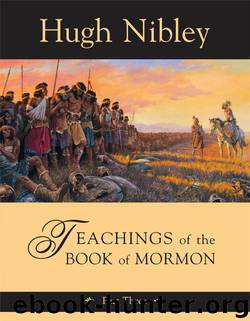Teachings of the Book of Mormon, Part Three by Hugh Nibley

Author:Hugh Nibley [Nibley, Hugh]
Language: eng
Format: epub
Tags: LDS, Book of Mormon, Religion, Mormon
ISBN: 9781621081074
Publisher: Deseret Book Company
Published: 2012-03-28T06:00:00+00:00
TEACHINGS OF THE BOOK OF MORMON
HUGH NIBLEY
Semester 3, Lecture 73
Alma 62–Helaman 1
Book of Mormon Names
The plot thickens now as we get closer and closer to home. We are in Alma 62. Of course, Moroni was very, very glad and relieved to receive Pahoran’s letter. I wonder if he felt cheap or something when he found out he had been completely wrong after all the shouting, raving, and ranting against Pahoran. His heart was filled with exceedingly great joy to find out that he wasn’t a traitor, as he thought he was. He really jumped the gun that time. But at the same time “he did also mourn exceedingly.” Moroni is something of a manic-depressive, isn’t he? He’s an overachiever, he’s a military genius, and he only lives a very short life. He just wears himself out, I think. He’s that sort of person. We get these beautiful character delineations in the Book of Mormon. We learn that things are often wrong with the world, but [we should] be careful how we place the blame. We don’t want to do things like that. After all, who raised Noriega to power?
Here is the sacral state. They had “rebelled against their country and also their God.” You can’t rebel against the country in a sacral state [without rebelling against God]. This is a religious state, like Israel. You don’t divide the state from the church. (In Utah it may be different.) The war isn’t up yet. They are going to have a mopping up operation. Verse 3: “...Moroni took a small number of men... and gave Lehi and Teancum command over the remainder of his army.” He said, I’m leaving them in your trust. I’m going to go out and join Pahoran, and we’ll clean up here. “And [again] he did raise the standard of liberty in whatsoever place he did enter.” This is traditional; the standard attracts people. Notice it says, “And it came to pass that thousands did flock unto his standard.” The Egyptians used the same word for standard that they used for rallying place or great ceremonial center. The word is iˆt. It’s usually written like this. As we find in the old pictures, it’s a mound
with megalithic stones around it. The iˆt is a sacred meeting place. This is the standard, and they would have the bird or one of the forty-two emblems of the tribes there on the standard. But the standard brings you to the meeting place, and it does here. It was the same thing in England. The king would raise his banner at Nottingham, and all the people would have to come. We find out in the sagas that when you received the heror, the war arrow of the king, you must come to his presence within three days or be banished for three years from the kingdom. This was a universal rule in the ancient world.
So thousands flocked to his standard. They were still observing these things. These things show remarkable uniformity, don’t they? We’ll find that right down to our own times they do.
Download
This site does not store any files on its server. We only index and link to content provided by other sites. Please contact the content providers to delete copyright contents if any and email us, we'll remove relevant links or contents immediately.
| Amish | Catholicism |
| Christian Science | Jehovah's Witness |
| Mennonite | Messianic Judaism |
| Mormonism | Orthodoxy |
| Protestantism |
Under the Banner of Heaven: A Story of Violent Faith by Jon Krakauer(1750)
The Early Centuries - Byzantium 01 by John Julius Norwich(1702)
The Amish by Steven M. Nolt(1533)
Taken by J. C. Owens(1529)
In Spirit and Truth (In Spiritu Et Veritate Series) by Reed Zoe(1525)
Play It as It Lays by Joan Didion(1475)
The Apogee - Byzantium 02 by John Julius Norwich(1413)
The Last Man in Russia by Oliver Bullough(1364)
A History of the Amish by Steven M. Nolt(1260)
David Sedaris Diaries by David Sedaris(1244)
Leaving the Witness by Amber Scorah(1214)
Fallen by unknow(1184)
The Dance of Change by unknow(1179)
Tears of the Silenced: A True Crime and an American Tragedy; Severe Child Abuse and Leaving the Amish by Misty Griffin(1178)
The Angel of Forest Hill by Cindy Woodsmall(1125)
The Best of Amish Cooking by Phyllis Pellman Good(1114)
Deep Blue by unknow(1104)
The Ariana Trilogy by Rachel Ann Nunes(1104)
Escape by Carolyn Jessop & Laura Palmer(1086)
